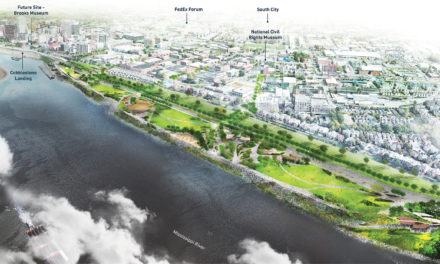There are so many reasons to take a new and bold look at the street network in downtown Memphis, beginning with Riverside Drive.
There’s the serious need for a road diet for a network whose traffic numbers are far below capacity – and that was the case long before the pandemic. There’s the network built more than half a century ago but has remained largely unchanged except for pedestrian Main Street despite smarter urban thinking about transportation. There is the epidemic of bottlenecks and traffic backups that are compounded by a lack of effective traffic management by MPD.
Most of all, Memphis leads the country in traffic fatalities and pedestrian fatalities, a statistic that calls for considering how streets are a cause. Assuming that the streets are not a factor is tantamount to considering that handgun proliferation is not a factor in the Memphis crime rate.
Back when downtown streets were laid out, only cars mattered and traffic engineers were king. Because of these results, many downtowns across the country have undertaken reviews that have produced major changes and more thoughtful plans for complete streets and more walkable downtowns.
The challenge to Memphis joining in this trend appears to be lack of political will trapped by a car-centric culture and mindset. A year ago this month, City of Memphis made some modest common sense recommendations for Riverside Drive that fell short for what was needed but were quickly abandoned by city officials shaken by a loud minority who push back on any change that resembles modern urban thinking about transportation.
Pavement Over People and Parks
While contending that it is working for “growth-minded public policies” that “create a more prosperous community for us all,” the Greater Memphis Chamber has rarely seen more lanes of asphalt as something it didn’t like or a change in street patterns as something that it would not dispute.
This car-centric focus is arguably continued by the Memphis Urban Area Metropolitan Planning Organization (MPO) which has fueled sprawl and failed to incentivize the innovation needed in traffic planning for our region.
It’s not like it’s an isolated point of view. After all, previous efforts involved Overton Park and it produced a landmark Supreme Court ruling that protected the historic park from the devastating impact of a six-lane expressway. Then there was also Shelby Farms Park where there was strong support for the six-lane Kirby/Whitten Parkway originally planned through the park.
It brings us to Riverside Drive and how it can best serve the safety and accessibility of the riverfront as it attracts more than one million visitors a year (and that’s before the new art museum and observation deck are opened) and as drivers exceed the posted speed limit (and they did it even when it was a two-lane experiment a few years ago).
What are the lessons of Overton Park and Shelby Farms Park that are relevant to the riverfront that has already attracted multiple awards and more than 70 national articles about its transformation?
Lessons Learned
First, local highways inspire emotional opinions that are often more about feelings than facts. Research proves that putting people and parks over pavement is the smart urban decision.
Jessie Grogan of the Lincoln Institute of Land Policy, who leads the organization’s work on reducing poverty and inequality, said: “No longer are cities being planned for cars and commuters from the suburbs; instead, their multiple roles as commerce centers, homes, and places of recreation and tourism are being acknowledged and encouraged.”
But does that actually apply to Memphis?
Second, highways do in fact damage a park, reducing its sense of wholeness and connectedness, splintering the potential of park goers’ positive experiences.
Third, Memphis was ahead of its time. Today, there is a movement across the U.S. to limit and close highways through parks. Peter Harnik, urban park expert, said when Riverside Drive was closed, “Memphians rallied to the riverfront for camaraderie.” City of Memphis bikeway and pedestrian program manager Nick Oyler added that “people flocked to it because there was twice as much space” for people to walk, bike, skate, and ride scooters.
Fourth, parks are special places where Memphis, in all its diversity, can come together to forge a shared sense of community and pride. Overton Park and Shelby Farms Park – and now Tom Lee Park – prove it every day.
Lastly, Overton Park and Shelby Farms Park were convincing rejections of the “it’s good enough for Memphis” attitude that for a century put cars first and quality of life second. It’s the attitude needed for a wise decision about the future of Riverside Drive.
Planners Are Trying But No One Listens
Memphis can hardly be accused of being a hub of modern, progressive urban thought. The lack of understanding about the importance of interventions and investments that produce transformative real estate, public space, and economic strategies and the accompanying impact, inclusion, and animation are enough at times to discourage even the most inveterate cheerleaders for Memphis.
There is no greater evidence to this lack of understanding than the current state of downtown, where the promise of a clean, green, and safe environment is sadly unmet. It’s a reminder of the U.S. Department of Justice studies that connect how the physical state of an area tells potential criminals that no one cares and that anything goes which in turn contributes to crime.
But that’s not saying that our own planners aren’t trying to get the right decisions to be made.
The Downtown Memphis Master Plan recommends:
“Reduce the number of lanes and add multimodal improvements including wider sidewalks, bicycle infrastructure, and other human-scaled amenities for South Fourth Street, North Manassas Street, North Dunlap Street, Riverside Drive, and Monroe Fourth, parks are special places where Memphis, in all its diversity, can come together to forge a shared sense of community and pride. Overton Park and Shelby Farms Park prove it every day.
And it says more: “A number of Downtown Memphis streets are too large, given their traffic volumes. Reducing the number of lanes would pave the way for public realm improvements while maintaining traffic flow…Some streets should be evaluated and considered for a road diet include South Fourth Street, North Manassas Street, North Dunlap Street, Riverside Drive, Monroe Avenue.”
Cities Making Change
There is much to like in the proposed master plan for downtown, particularly the fresh look at the number of lanes in streets, at whether they are pedestrian and bike-friendly, well-lighted, signed well, and connected to the riverfront.
As for Riverside Drive, the number of vehicles travelling on the highway is 30% lower than it was a decade ago. The disparity between street capacity and traffic count is emblematic of the underuse and inefficiency of the downtown street grid. The traffic count and capacity for key streets are: Second Street – 5,807 vehicles, 24,000 capacity; Third Street/B.B. King – 7,985 vehicles, 24,000 capacity; Front Street – 7,494 vehicles, 24,000 capacity; and Crump Boulevard – 13,364 vehicles, 48,000 capacity.
With cities on the cusp of new transportation technologies, especially mobility-on-demand and the rise of autonomous vehicles, the report by the Downtown Memphis Commission emphasized the need to consider more efficient streets. The recommendations about Riverside Drive were just the latest that suggest Riverside Drive can be sized in a way that better serves the aspirations of downtown.
For at least eight years, I’ve been blogging about the need to right-size Riverside Drive to improve downtown’s livability, to increase safety, and to improve access to the riverfront. After writing previously about this, I’ve received emails that suggested that only Memphis would even think of doing “something as stupid” as changing its riverfront street.
And yet, that’s not true.
There are cities all over the U.S. who have rethought and are rethinking their waterfront streets and highways to the point that many are even removing them altogether, because in taking a traffic engineering view of cities, the urban fabric was sacrificed for speed and commuters.
Boston removed sections of I-89, creating more than 45 parks and public plazas, and rerouted I-93 to create a linear park with landscaped gardens, promenades, plazas, fountains, art, food trucks, farmers’ markets, carousel and specialty lighting. Public space, walking and biking paths, and new transit routes are now where the Embarcadero Freeway in San Francisco once stood. Rochester, New York, filled in almost a mile of I-490 to create a complete street that reconnected neighborhoods with walking and biking paths.
Milwaukee demolished an interstate and new development blossomed on both sides of a boulevard. New Haven, Connecticut, demolished part of a highway and spurred new downtown development. Philadelphia is removing concrete ramps of an interstate which obscured views of the river and built a cap over the interstate covered by an 11-acre landscaped park that is a walkable link from the Old City to the river’s edge.
There are similar projects in Dallas, Albany, Austin, Detroit, Oakland, Syracuse, and more.
A Warning about Traffic Engineers
Old car-centric ideas die hard.
As urban planner and author Jeff Speck warned, after evaluating the riverfront in Memphis in 2013, said: “Don’t let traffic engineers determine your quality of life.”
Joe Cortright of City Observatory described it this way: “We took an engineering view of cities, one in which we needed to optimize our transportation infrastructure to facilitate the flow of automobiles. The massive investments in freeways (and the rewriting of laws and culture on the use of the right of way) made cities safer for long-distance, high-speed – but at the same time produced massive sprawl, decentralization, and longer journeys, and eviscerated many previously robust city neighborhoods.”
University of Tennessee’s Ted Shelton and Amanda Gann of the architecture school wrote: “Where urban highway construction did occur, in urban design terms, it was highly detrimental to the urban fabric; creating physical and psychological rifts that are extremely difficult to bridge and introducing a substantial source of noise and air pollution. Cities across the country continue to struggle with this legacy.”
Powerful roadbuilding lobbies and Chambers of Commerce have imbedded its primary talking point – “highways are economic arteries” – into the minds of politicians at all levels of government – and backed up by political contributions. The results can be seen in the sprawl of suburban and rural Shelby County which took county government to the verge of bankruptcy.
A variation of the Chamber mantra justifying more roads was that sprawl was actually “growth” when in fact, they were perpetuating – and incentivizing – a major and historic relocation of Memphians outside of the city.
In this way, the county government that depended on the important support from Memphis for revenues and economic activity did in fact undermine its health on the belief that “all roads are good roads.”
As for Riverside Drive, Memphis has an opportunity to be a leader in the treatment of its waterfront by right-sizing the street to become what it aspires to be – a safe, accessible connector between neighborhoods in downtown, South Memphis, and North Memphis and their riverfront.
**
Join me at the Smart City Memphis Facebook page and on Instagram where these blog posts are published along with occasional articles, reports, and commentaries that are relevant to Memphis.






